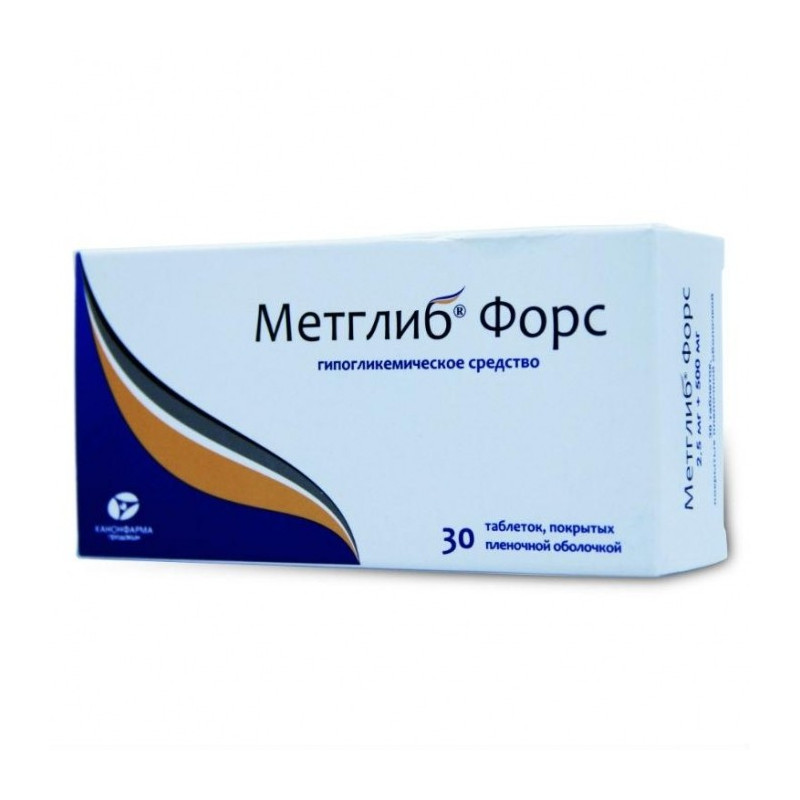



 All payments are encrypted via SSL
All payments are encrypted via SSL
 Full Refund if you haven't received your order
Full Refund if you haven't received your order
Oral combined hypoglycemic agent, sulfonylurea derivative II generation.
It has pancreatic and extra-pancreatic effects.
Glibenclamidestimulates insulin secretion by lowering the glucose stimulation threshold of beta cells of the pancreas, increases insulin sensitivity and its binding to target cells, increases insulin release, enhances the effect of insulin on glucose absorption by muscles and liver, inhibits lipolysis in adipose tissue. Acts in the second stage of insulin secretion.
Metformin inhibits gluconeogenesis in the liver, reduces the absorption of glucose from the gastrointestinal tract and increases its utilization in the tissues; reduces the content of TG and cholesterol in the serum. Increases insulin binding to receptors (in the absence of insulin in the blood, the therapeutic effect is not manifested). Does not cause hypoglycemic reactions.
The hypoglycemic effect develops after 2 hours and lasts 12 hours.
Glibenclamide is rapidly and completely (84%) absorbed in the gastrointestinal tract, the time to reach Cmax - 7-8 h.
Communication with plasma proteins - 97%.
Almost completely metabolized in the liver to inactive metabolites.
50% excreted by the kidneys, 50% - with bile. T1/2 - 10-16 h.
Methformin after absorption in the gastrointestinal tract (absorption - 48-52%) is excreted by the kidneys (mostly unchanged), in part by the intestines. T1/2 - 9-12 h.
Type 2 diabetes mellitus (with the ineffectiveness of diet therapy or monotherapy with oral hypoglycemic drugs).
For oral administration, during meals. Dosing regimen is selected individually.
Typically, the initial dose is 2.5 mg of glibenclamide and 500 mg of Metformin, with a gradual dose adjustment every 1-2 weeks. depending on the glycemic index.
The maximum daily dose is 2.5 or 5 mg of glibenclamide and 500 mg of metformin.
Gastrointestinal: nausea, vomiting, abdominal pain, loss of appetite, "metallic" taste in the mouth, decrease in absorption and, as a result, plasma cyanocobalamin concentration (with long-term use), discomfort in the epigastric region, increased activity of hepatic transaminases, hepatitis.
From the skin: erythema (as a manifestation of hypersensitivity), photosensitivity, pruritus, maculo-papular rash (including on mucous membranes), urticaria.
Metabolism: lactic acidosis, hypoglycemia, skin and liver porphyria; hyponatremia, hypercreatininemia, increased urea in the blood plasma.
Hemic and lymphatic: leukopenia, thrombocytopenia, agranulocytosis, hemolytic anemia, bone marrow aplasia, pancytopenia.
Other: disulfiram-like reactions (when used simultaneously with ethanol).
Hypersensitivity; type I diabetes; diabetic ketoacidosis; diabetic precoma and coma; lactic acidosis (including in history); renal failure (creatinine more than 135 mmol / l in men and more than 110 mmol / l in women); acute conditions that can lead to impaired renal function (including dehydration, severe infections, shock, intravascular injection of iodine-containing contrast media); acute and chronic diseases accompanied by tissue hypoxia (including heart failure, respiratory failure, recent myocardial infarction, shock); liver failure; acute alcohol intoxication; porphyria; simultaneous use of miconazole; pregnancy; lactation period.
C caution: alcoholism, adrenal insufficiency, hypofunction of the anterior pituitary gland, thyroid disease with impaired function.
Contraindications: pregnancy; lactation period.
Contraindications - liver failure.
Contraindications - renal failure (creatinine more than 135 mmol / l in men and more than 110 mmol / l in women).
Large surgical interventions and injuries, extensive burns, infectious diseases with febrile syndrome may require the abolition of oral glypoglycemic drugs and insulin administration.
It is necessary to regularly monitor the content of glucose in the blood on an empty stomach and after a meal, the daily curve of glucose in the blood.
Patients should be warned about the increased risk of hypoglycemia in cases of taking ethanol, NSAIDs, during fasting.
Dose adjustment is necessary for physical and emotional overstrain, change in diet.
With caution prescribed during therapy with beta-blockers.
With the symptoms of hypoglycemia, carbohydrates (sugar) are used, in severe cases, a dextrose solution is slowly injected / in.
It is necessary to cancel the drug 2 days before any angiographic or urographic examination (therapy resumes 48 hours after the examination).
Against the background of the use of ethanol-containing substances, disulfiram-like reactions may develop.
Influence on ability to drive vehicles and mechanisms
During the period of treatment, care must be taken when driving vehicles and engaging in other potentially hazardous activities that require increased concentration and psychomotor reactions.
Miconazole- the risk of hypoglycemia (up to coma).
Fluconazole- risk of hypoglycemia (increases T1/2 sulfonylurea derivatives).
Phenylbutazone can displace sulfonylurea derivatives (glibenclamide) from the association with proteins, which can lead to an increase in their concentration in the blood plasma and the risk of hypoglycemia.
Applicationiodine radiopaque preparations (for intravascular administration) can lead to the development of renal dysfunction and cumulation of metformin, which increases the risk of lactic acidosis. Treatment with the drug is canceled 48 hours before their introduction and resume no earlier than 48 hours.
Applicationethanol-containing funds against glibenclamide may lead to the development of disulfiram-like reactions.
GCS, beta2- adrenostimulators, diuretics may lead to a decrease in the effectiveness of the drug; may require dose adjustment of the drug.
ACE Inhibitors - the risk of hypoglycemia in the background of the use of sulfonylurea derivatives (glibenclamide).
Beta blockers increase the incidence and severity of hypoglycemia.
Antibacterial drugs from the group of sulfonamides, fluorochonolones, anticoagulants (coumarin derivatives), MAO inhibitors, chloramphenicol, Pentoxifylline, hypolipidemic drugs from the group of fibrates, disopyramide - the risk of hypoglycemia against the background of glibenclamide.
